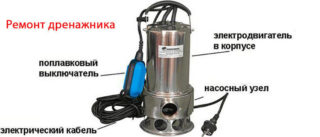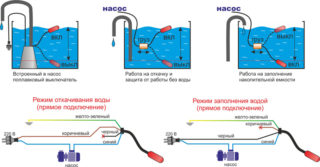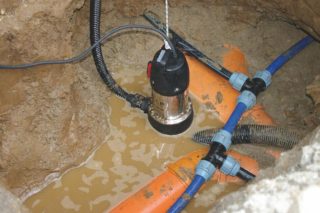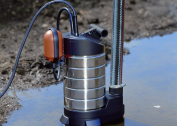Drainage pumps in summer cottages perform not the most pleasant operations. With their help drain sewers, pools, cellars are drained, they help septic tanks to discharge purified (clarified) water outside the territory. But, like all equipment of this type, drainage pumping units tend to fail over time. Therefore, the moment comes when the repair of drainage pumps is required.
How is the drainage pump
 This type of pumping equipment is classified as centrifugal. An impeller is mounted on the motor shaft, which pumps water. A large number of different models work on this principle. But the drainage differs from the others in that its impeller is made of steel, while the walls of the blades are thicker than conventional devices. In addition, the passage between the body of the unit and the walls enclosing the feed chamber and the compartment where the electric motor is located is larger. This allows you to freely move around the gap in sand, small pebbles, organic inclusions and other large particles.
This type of pumping equipment is classified as centrifugal. An impeller is mounted on the motor shaft, which pumps water. A large number of different models work on this principle. But the drainage differs from the others in that its impeller is made of steel, while the walls of the blades are thicker than conventional devices. In addition, the passage between the body of the unit and the walls enclosing the feed chamber and the compartment where the electric motor is located is larger. This allows you to freely move around the gap in sand, small pebbles, organic inclusions and other large particles.
Manufacturers offer drainage pumps with float switches. The latter responds to the level of pumped water. And if it drops to a critical level, the pump immediately turns off. The float acts as a dry run protection.
Breakdown reasons
The causes of malfunctions of drainage pumps are not many. But identifying one of them is not always easy. In addition, a unit that has worked for many years or has just been purchased may fail. In the latter case, this may be a factory defect, or errors were made during the installation of pumping equipment. For example, the pump was lowered to an insufficient depth, so the suction hole was above the surface of the water surface.
Most often, all malfunctions manifest themselves during the operation of the device. It is very important to properly operate it according to the control parameters that the manufacturer must indicate in the product passport. If the pumping device is not used correctly, the loads will simply destroy it, damage the working units and parts. Such control parameters include the sizes of particles located in the pumped water. If they are more than indicated in the passport, this will primarily lead to failure of the impeller or electric motor.
The same can be said if the pump unit is idling. The motor is cooled by pumped water. If it does not get into the pump casing, after a few minutes of operation the motor will overheat and there is a high probability that its windings will burn out.
Lack of prevention can also cause the failure of the drainage pump. A large number of failures can be prevented if the prerequisites for their occurrence are discovered in time.
Types of breakdowns and methods for their elimination
It is possible to divide breakdowns into simple and complex. The latter can not be fixed with your own hands. For example, repair an electric motor. The category of simple ones includes malfunctions that can be fixed without contacting a service center. Usually this is a replacement of a failed part with a new or banal cleaning of the insides of the pump unit.
The commonplace situation is the drain pump does not work with float switch - does not turn on if necessary.
Causes:
- The power cable is out of order. This often happens when it is bent, twisted, or one of the device terminals has moved away during transportation.It is not always possible to find a break, so the best solution is to replace it with a new wire. It is important to correctly open the terminal box cover. Under it is a rubber gasket, which creates a tight seal to the box. If the cuff breaks, you will have to change it. The main task when replacing the power cable is to accurately connect the wires of the new wire to the terminals. You can’t mix anything up.
- One reason concerns the float switch itself. It works on the principle of a lever, which either connects the terminals to each other, which is why power is supplied to the electric motor, then disconnects them. It often happens that the contact plane of the terminals is covered with dirt or rust. They just need to be cleaned by any means, for which you have to disassemble the drain pump with an external float, clean the terminals and reassemble the device.
- Sometimes there is a kink in the wire that connects the float to the pump. To check whether this is actually so, it is necessary to install a new wire in parallel and try to turn on the pump. If it works, the problem is in the cable. It must be replaced.
The reasons are actually simple. But it’s not always necessary to deal with them yourself. A device located in water will create big problems with opening it due to rusted fasteners. Therefore, it is better to take it to a service center.
Second breakdown: the electric motor is buzzing, but the pump does not pump water. Causes:
- the feed pipe is clogged;
- large impeller wear or complete kink of the blades;
- the size of the impurities in the pumped water is more than passport;
- mains voltage has dropped.
The first problem is not difficult to solve. It is necessary to lift the pump from the well, unscrew the feed hose and rinse it with a water pressure. The second is solved by more complex manipulations - it is necessary to replace the impeller with a new one, opening the liquid suction chamber. The problem with the voltage drop is solved by installing a step-up transformer in the power supply network.
Third trouble: the pump is buzzing but don't spin. This is one of the most difficult failures, which is based on jamming of bearings. With your own hands, if you are not a specialist in the repair of pumping equipment, you can’t eliminate this trouble. But there is another reason, no less unpleasant. One of the motor windings may burn out. It will have to be changed to a new one or to be repaired in terms of installing new windings (all without exception, even intact).
When the drain pump is turned on, the machine knocks. There are two reasons:
- short circuit between the turns of the motor winding;
- short circuit between the conductors of the power cable.
The first reason is impossible to cope on your own. The pump will have to be taken to a service center. As practice shows, even in the center of the master do not take up the rewind of the engine. Therefore, the best option is to purchase a new pump. The second problem can be solved independently. The main thing is to determine exactly what it is causing the machine to knock out. To do this, you can use the multimeter by checking the wire for resistance.
To avoid serious damage, it is recommended to periodically inspect the equipment and its prevention.
Prevention and maintenance of the drainage pump
In order for the pumping unit to serve for a long time and to create big problems, one must follow the manufacturer's recommendations. This applies to the rules of installation and operation.
Once a year, drainage pumps must be opened and cleaned of sticky dirt and debris inside the device compartments. At the same time, parts are checked for wear. This primarily relates to the protective mesh located inside the suction pipe and the impeller. The latter has special requirements: it should not be smaller in size. This affects the performance of the unit. If the impeller has become smaller, it must be replaced.
Be sure to check the float during the maintenance process, open the terminal box in which the contacts are cleaned. The supply wire is checked for kinks and breakage detection. Please note that even a simple cleaning of the internal cavities of the drainage pump will increase its service life by several times.




